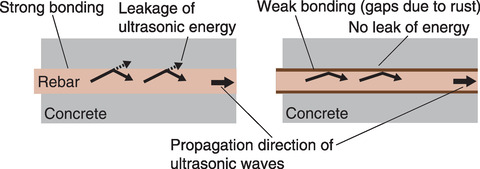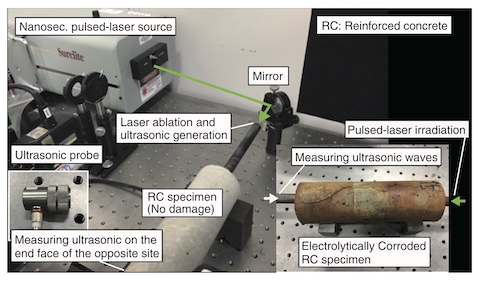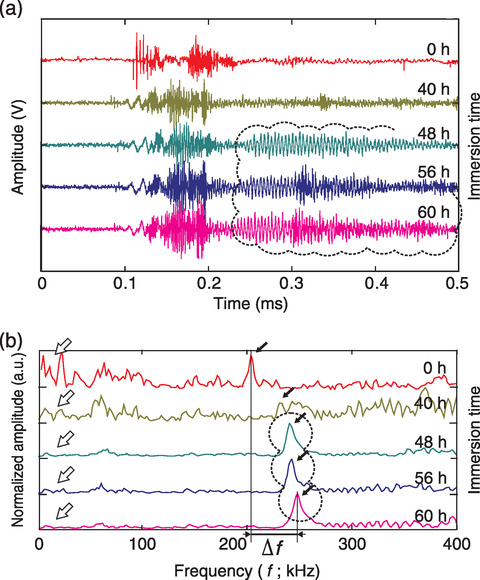
Fig.1-16 Corrosion process of RC

Fig.1-17 Differences in the propagation of ultrasonic waves through rebar due to the degree of bonding to the surrounding concrete

Fig.1-18 Experimental setup and specimen used for measuring ultrasonic waves propagating through the RC rebar

Fig.1-19 A collection of ultrasonic signals in the (a) time and (b) frequency domain at the same immersion time interval
The structural integrity of the buildings damaged by earthquakes and hydrogen explosions must be maintained to complete the long-term decommissioning of TEPCO's Fukushima Daiichi NPS safely and smoothly. Additionally, technology capable of detecting and evaluating the deterioration of the buildings is needed to prevent further damages caused by future earthquakes. During the accident, seawater penetrated the reactor; further, the buildings are still exposed to rain. Therefore, we developed a non-destructive method to evaluate the corrosion of reinforced concrete (RC).
The deterioration process of RC by corrosion is summarized in Fig.1-16. Rebar and the surrounding concrete are tightly bonded when healthy; as deterioration progresses, however, the degree of bonding decreases. Due to this change in bonding, the waveforms of the ultrasonic waves propagating through the rebar vary, suggesting that the level of deterioration might be detectable from the changing waveforms (Fig.1-17).
Therefore, we investigated the correlation between the degree of the bonding and waveform of the ultrasonic wave using the experimental setup and specimen shown in Fig.1-18. Here, bonding degradation was simulated by electrolytic corrosion. The ultrasonic wave was excited by irradiating the cut surface of the rebar with a nanosecond pulsed laser. The waveforms were measured using an ultrasonic probe on the opposite cut surface of the rebar. After measuring the ultrasonic waveforms, the specimen was subjected to electrolytic corrosion. The obtained ultrasonic waveforms after varying immersion times are shown in the time and frequency domains in Figs.1-19(a) and (b), respectively.
Characteristic resonance waveforms were present after 48 hours of immersion (as indicated by the dotted line). In the frequency domain, these waveforms were noticeable as a decrease in the low-frequency component. These waveforms were caused by the change in wave propagation owing to the weakening of the bonding. The resonance of the ultrasonic wave at the cut surface of the rebar causes these signals. Δf indicates that the peak of these signals shifted toward the high-frequency side as the rebar diameter decreased due to electrolytic corrosion (Fig.1-19(b)).
These resonant signals are correlated with the diameter of the rebar; deterioration via corrosion thus progressed as the intensity of the low-frequency component decreased and the signal peaks shifted to the high-frequency region. Our findings indicate that ultrasonic waves propagating through rebar can be used to detect and evaluate the corrosion of RC.
(Akinori Furusawa)